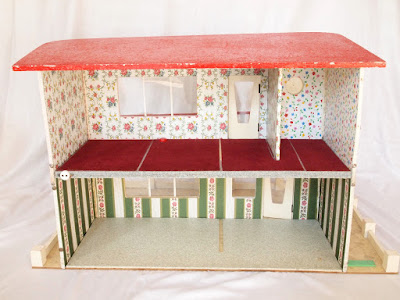Diese Puppenstube, vermutlich von Elfriede Lipfert, Elka, ca. 1956,
habe ich mit acht verschiedenen Holzwohnzimmern aus dieser Zeit eingerichtet,
die ich bis jetzt nur in Kartons aufbewahrt habe.
Eines davon darf jetzt in diese Stube einziehen.
Welches Set passt am besten?
I have furnished this doll's house, presumably by Elfriede Lipfert, Elka, ca. 1956,
with eight different wooden living rooms from this period,
which I have only kept in boxes until now.
One of them may now move into this parlour.
Which set fits best?
with eight different wooden living rooms from this period,
which I have only kept in boxes until now.
One of them may now move into this parlour.
Which set fits best?
Im letzten Beitrag waren die westdeutschen Hersteller Altmann und Crailsheimer dran,
hier folgen jetzt die ostdeutschen und ich beginne mit EMS.
Auf dem Foto sehen wir ein komplettes Set, im Katalog von 1959 zu sehen,
aber da es etwas leer wirkte, selbst in dieser kleinen Stube,
habe ich es mit anderen Möbeln von EMS aus meinen Kartons ergänzt.
In the last post it was the turn of the West German manufacturers Altmann and Crailsheimer,
here now follow the East German ones and I start with EMS.
On the photo you see a complete set, to be seen in the 1959 catalogue,
but since it looked a bit empty, even in this small room,
I have supplemented it with other furniture from EMS from my boxes.
here now follow the East German ones and I start with EMS.
On the photo you see a complete set, to be seen in the 1959 catalogue,
but since it looked a bit empty, even in this small room,
I have supplemented it with other furniture from EMS from my boxes.
Dies ist das originale Set - mit einer westdeutschen Cacopuppe.
This is the original set - with a West-German Caco doll.
Und hier ist die ostdeutsche Caho-Puppe zur Dekoration zu sehen,
sie trägt fast dasselbe Outfit,
obwohl sie auf der anderen Seite des Eisernen Vorhangs hergestellt wurde.
And here you can see the East German Caho doll,
she wears almost the same outfit,
although she was made on the other side of the Iron Curtain.
Im Fernsehen läuft das Sandmännchen.
Wohl etwas später kam dieses Paul Hübsch Ensemble heraus.
Durch das helle Holz und die leuchtenden Farben der Sesselbezüge
wirkt es sehr freundlich.
This Paul Hübsch ensemble probably came out a little later.
The light wood and bright colours of the chair covers
give it a very friendly appearance.
The light wood and bright colours of the chair covers
give it a very friendly appearance.
Die bunten Tiere der Arche Noah passen sehr schön zur bunten Lampe.
The colourful animals of Noah's Ark correspond with the colours of the lamp.
All colours are mirrored on the wall paper and on the curtain.
A chimney sweep for good luck.
Die Rülke-Schränke wirken dagegen wieder sehr schwer.
The cupboards by Rülke appear to be heavily weighted in comparison.
Etwas mehr Leichtigkeit bringt die moderne Polstergarnitur ins Bild.
Whereas the sofa and the chairs bring easiness and elegance into the picture.
Dieses Wohnzimmer des VEB Möbelfabrik Wehrsdorf ist selten zu sehen -
es müsste also endlich mal einen Platz in einem Puppenhaus finden.
Den Tisch habe ich von einem anderen Hersteller ergänzt.
This living room is rare and should be displayed somewhere in my collection.
The table is not original.
Als letztes ein Wichtelmarke-Wohnzimmer.
Auch hier wirkte die Stube etwas leer,
deshalb ergänzte ich noch einen Musikschrank.
The last living room is by Wichtelmarke.
Again, as the room was still quite empty
I added a music box.
Die Hertwig-Biegepuppen-Familie durfte
auch mal zu einem Fototermin aus ihrer Vitrine.
The family of flexible dolls made by Hertwig
had a rare trip out of their display case home.
Choosing the most beautiful living room for this room box will be hard.
Wenn nicht anders vermerkt, sind alle Fotos aus meiner Sammlung
Dieses Werk ist lizenziert unter einer Creative Commons Namensnennung - Nicht kommerziell - Keine Bearbeitungen 4.0 International Lizenz.

.JPG)

.jpg)
.jpg)
.JPG)
.jpg)
.jpg)
.jpg)
.JPG)
.jpg)
.JPG)
.jpg)
.jpg)
.jpg)
.JPG)
.JPG)
.jpg)
.JPG)









.jpg)
.jpg)
.jpg)
.jpg)
.jpg)

.jpg)
.jpg)





.jpg)
.jpg)
.jpg)


.jpg)

.jpg)

.jpg)
.jpg)


.jpg)
.jpg)
.jpg)
.jpg)
.jpg)
